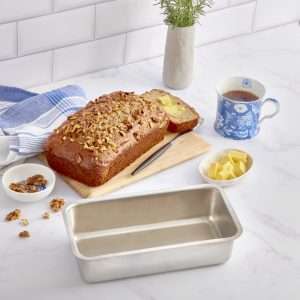Is 18 10 stainless steel good for cooking?
If you’ve ever looked into a busy professional kitchen, you’ll notice stainless steel everywhere. Chefs choose it not because it’s trendy, but because it’s dependable. It handles heat, it lasts through years of service, and it doesn’t get in the way of flavour. For home bakers, those same qualities matter just as much.
Stainless steel is also a trusted alternative to reactive metals or coated pans. There are no surface layers that can peel, and it won’t interfere with the food you’re preparing. It’s a material that lets you focus on the recipe itself, knowing the bakeware will do its job quietly in the background.
In this blog we’ll cover your top questions, including what 18/10 means, 18/10 vs 18/8, is 18 10 stainless steel good for cooking, and the science behind what makes it such a reliable material.
What does 18/10 stainless steel mean?
Not all stainless steel is the same. The numbers you see stamped on a tray or pan tell you about its makeup:
- 18% chromium creates a natural barrier against rust and staining.
- 10% nickel adds strength, shine, and resistance to pitting over time.
18/10 vs 18/8 stainless steel
You’ll also come across 18/8 stainless steel, which is what our bakeware is made from. The difference comes down to the nickel content: 18/10 has 10% nickel, while 18/8 has 8%. In practice, both perform the same for everyday baking and cooking.
18/10 is often used in pots, pans, cutlery and cookware that spends more time with highly acidic foods or long, slow cooking. For bakeware, 18/8 provides the same durability, rust resistance and non-reactive surface, making it ideal for everything from cakes to slices.
If you live with a nickel sensitivity, there are alternatives. Grades like 18/0 contain chromium but no nickel. They don’t resist corrosion quite as well, but they’re a solid option for those who need to avoid nickel altogether.
Read more on our stainless steel grades here.
Why stainless steel is good for cooking
Stainless steel has earned its place in everyday kitchens for a reason. A few of the qualities home cooks and bakers appreciate most include:
- True flavour: it doesn’t react with acidic foods like lemon or tomato.
- Durability: it resists scratches, dents, and rust.
- Oven-friendly: there are no coatings to worry about at high heat.
- Easy to clean: the smooth surface washes up without fuss.
- Consistency: good stainless steel distributes heat evenly, helping prevent burnt edges or underdone centres.
Is stainless steel good for baking cakes?
For baking, even heat and reliability make all the difference. Stainless steel does both well.
- Cakes rise evenly without hot spots.
- Fruit or citrus bakes keep their flavour without a metallic aftertaste.
- Pans last for years, through birthdays, weekend bakes, and everyday loaves.
To avoid sticking, a little prep goes a long way: line with baking paper or grease lightly, and you’ll enjoy reliable results time after time.
Are 18/10 and 18/8 stainless steel products sustainable?
Yes! Another reason stainless steel has become a kitchen favourite is its longevity. A good pan or tray can last for decades without impacting performance. Choosing materials that stand the test of time means you’re not replacing them every couple of years, which cuts down on waste and overconsumption.
Stainless steel is also fully recyclable. At the end of its long life in the kitchen, it can be melted down and repurposed without losing its strength. For many home bakers, that makes it a more thoughtful choice – a material that supports both reliable cooking and a lower-waste lifestyle.
Stainless steel for everyday baking
For anyone curious about switching to stainless steel at home, it’s worth trying it out in the bakes you make most. A muffin tray, loaf tin or baking tray is often where people start. With stainless steel, you’ll get something that feels at home in your kitchen, works reliably, and holds up well over time. Browse our full collection online.


